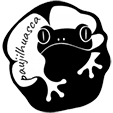
The Legend of the Eagle and the Condor
The legend of the Eagle and the Condor comes from time immemorial and is spread throughout Central and South America: it speaks of two groups of people, those of the eagle’s lineage and those descended from the condor. The eagle represents the north, masculinity, rationality, and science. On the other hand, the people of the condor are intuitive, creative, sensitive and primordially connected to the female energy and the south. These two groups have competed with one another since the beginning of the time. This legend talks about cycles of time, Pachakuti, lasting 500 years. The previous cycle started around 1490, the time of the European invasion of the Americas, and it finished around 1990. In this cycle, the People of the Eagle stood victorious, bringing a society based on rational thinking, industrialization, individualism, and masculine power. This Pachakuti corresponds with the time of repression of native cultures connected with mother nature. Since 1990, the people of the condor have started to rise again, looking for balance. This time in which we live, according to the legend, is the time of the reconciliation of the feminine with the masculine, intuition with rationality, individualism with collectivism. In this context, the legend of the canoe of medicines is born, where the ancestral medicines and spiritual practices of North and Central America combine with those of South America. The canoe of medicines carries ayahuasca and peyote, bufo and yopo, tamascal, kambo, vision quest, sun dance, along with the rituals of coca, magic mushrooms, and San Pedro.
Following this idea, the Paojilhuasca medicine centre combines all of these medicines and practises to treat people in as holistic and personalized way as possible, following each person’s natural predisposition and tendencies. For this reason Paojilhuasca collaborates with shamans from Mexico, Colombia and Brazil.
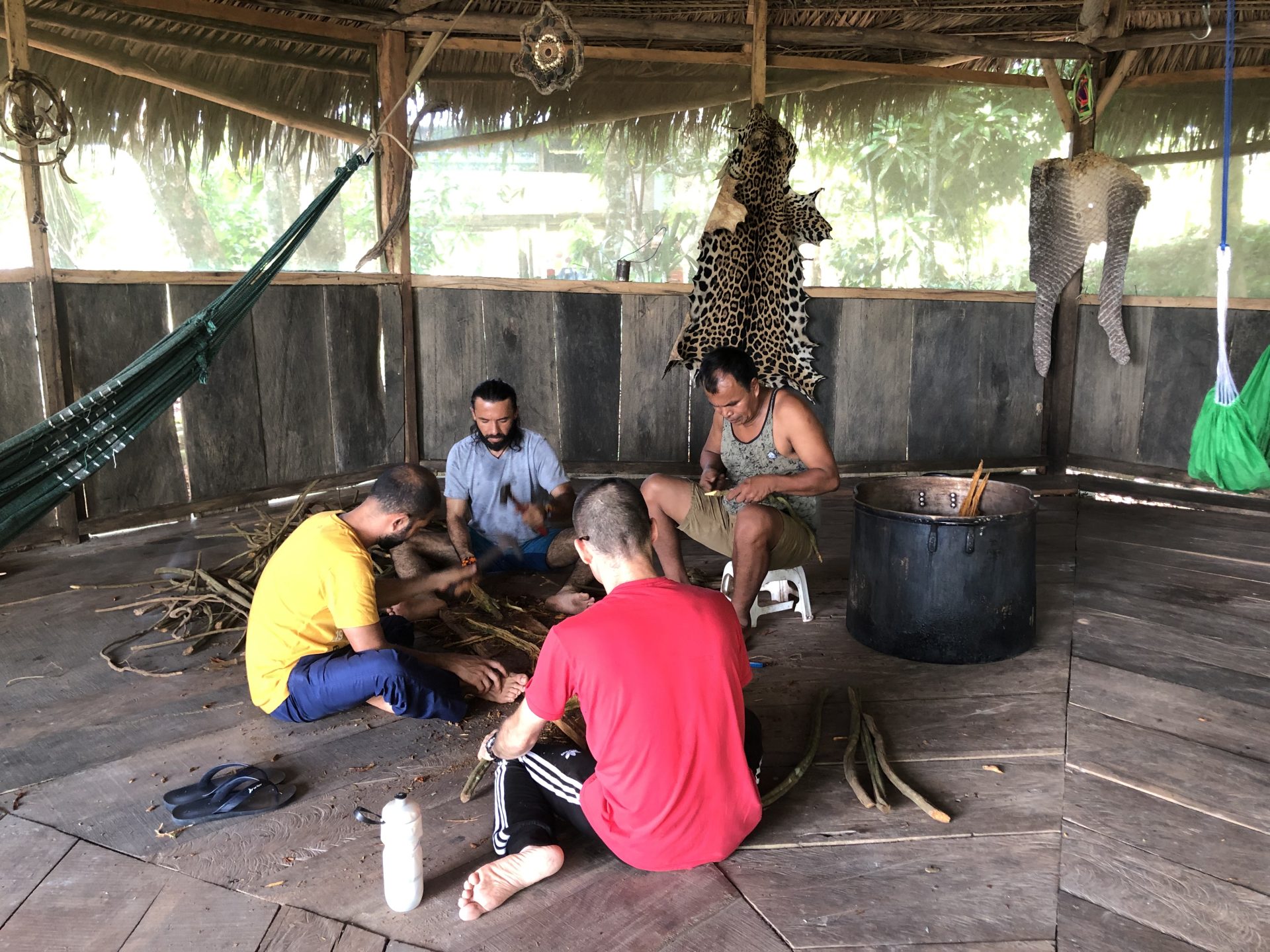
Ayahuasca
The word ayahuasca comes from two Quechua words: aya, meaning ‘spirit’, ‘soul, or ‘ancestor’, and huasca, meaning ‘vine’ or ‘rope’. Hence it is known as “the vine of soul.” It is also referred to as “la purga” due to the belief that it cures the soul, offering a deep introspective journey that enables the user to examine their emotions and ways of thinking. It plays a central role in the spiritual and cultural traditions of the Amazon and, in 2008, was constitutionally recognised by the Peruvian government as a National Treasure.
Its ceremonial use dates back thousands of years. One of the earliest objects related to it is a specially-engraved cup, now a museum piece, which was found in the Amazon around 500 BC, indicating that ayahuasca has been used as a sacrament for at least 2,500 years.
The brew is made from ayahuasca vine (Banisteriopsis caapi) and the leaves of the chacruna plant (Psychotria viridis) or huambisa (in Colombia called Chaliponga / Chagropanga) (Diplopterys Cabrerana). The resulting brew contains the powerful psychedelic drug DMT, coming from the chacruna and huambisa, and MAO inhibiting harmala alkaloids, derived from the ayahuasca vine, which are necessary to make the DMT orally active.
The ayahuasca mixture is prepared by adding the vines and leaves to water and boiling it for several hours so that it reduces to a thick brown potion that one eventually drinks. The shaman oversees the entire process, often blowing good intentions for healing and tobacco smoke into the mixture (a procedure known as soplada), singing magical chants called icaros to it, and offering prayers to the ayahuasca spirits for a successful ceremony to follow.
People who have consumed ayahuasca report having mystical experiences and spiritual revelations regarding their purpose on earth, the true nature of the universe, and deep insight as to how to maximize their potential. Many people also report therapeutic effects, especially around depression and personal traumas.
Many view ayahuasca ceremonies as a spiritual awakening, and some even lead to what is often described as a near-death experience or rebirth. It is often reported that individuals feel they gain access to higher spiritual dimensions and make contact with various spiritual or extra-dimensional beings who can act as guides or healers.
The experiences that people have while under the influence of ayahuasca are also culturally influenced. Westerners typically describe experiences with psychological terms like “ego death” and understand the hallucinations as repressed memories or metaphors of mental states.
Vomiting can follow ayahuasca ingestion; this is considered by many shamans and experienced users of ayahuasca to be a purge, an essential part of the experience representing the release of negative energy and emotions built up over the course of one’s life. Others report purging in the form of diarrhea and hot/cold flashes.
The ayahuasca brew furnishes potential antidepressant and anxiolytic effects. For example, a 2018 study reported that a single dose of ayahuasca significantly reduces symptoms of treatment-resistant depression in a small placebo-controlled trial. More specifically, statistically significant reductions of up to 82% in depressive scores were observed between baseline and 1, 7 and 21 days after ayahuasca administration.
Ayahuasca has also been studied for the treatment of addictions and shown to be effective, with lower Addiction Severity Index scores seen in users of ayahuasca compared to controls
Several studies have shown the alkaloids in the B. caapi vine promote neurogenesis. More specifically, in vitro studies showed that harmine, tetrahydroharmine and harmaline, stimulated neural stem cell proliferation, migration, and differentiation into adult neurons. Test subjects performed better on memory tasks compared to a control group.
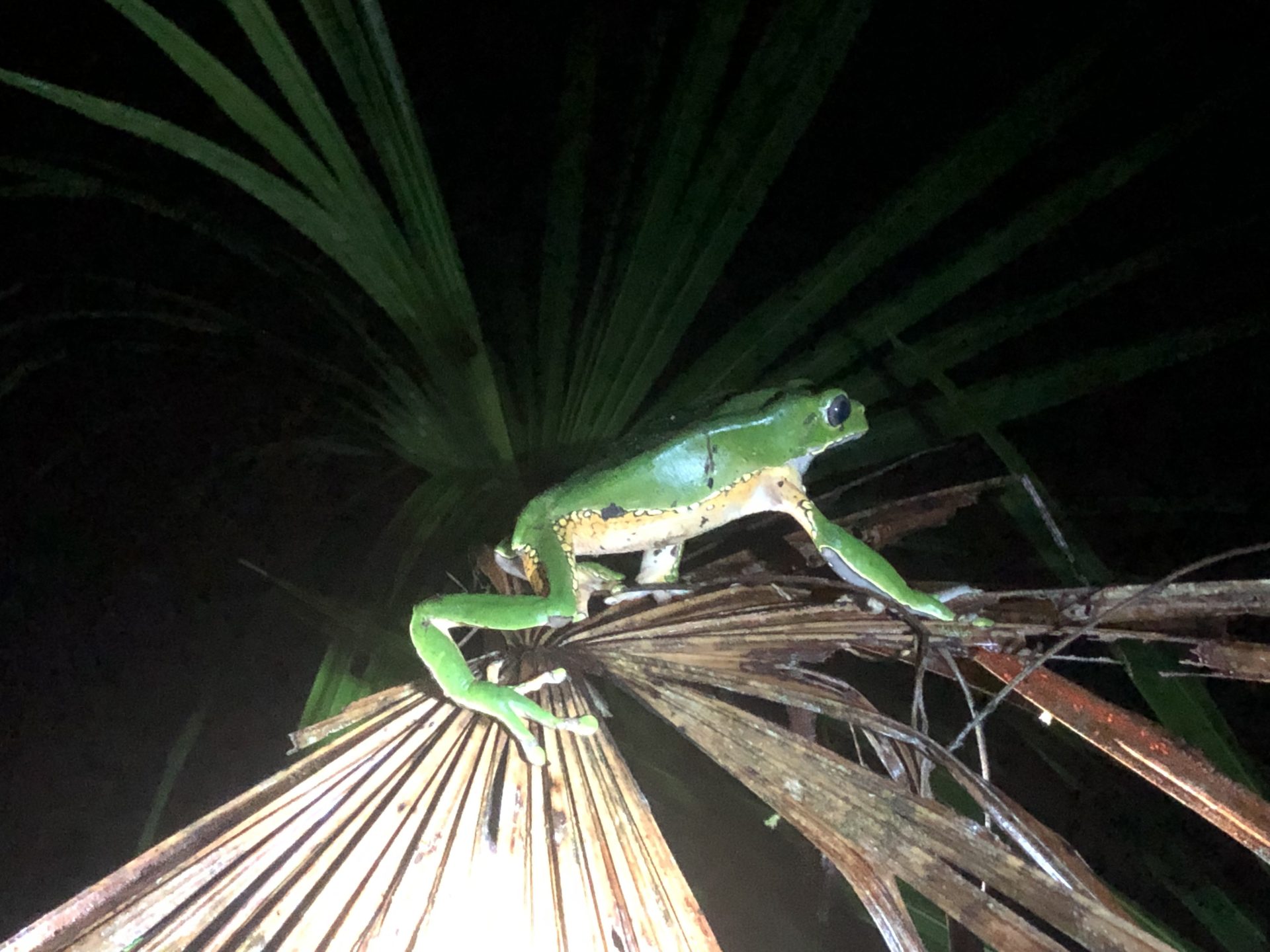
Kambo
Indigenous tribes of the western Amazon have considered kambo, or sapo, an “ancestral medicine” for over 2000 years. The secretion of the kambo frog (Phyllomedusa bicolour) is the medicine. At the beginning of the 20th century, the great drought in northeastern South America produced a migration of people to the western jungle to work in the rubber factories. This mass movement favoured the rediscovery of kambo and its use by non-indigenous populations outside of native tribes in the jungle. Its peculiar effects piqued curiosity and motivated scientific studies to research its composition as well as to determine its bioactive properties.
While studies on indigenous tribes using Kambo began in the 1930s, it was anthropologist and journalist Peter Gorman who, in around 1980, documented his experiences with kambo in his article “Making Magic” and sent samples of the secretion of the Phyllomedusa Bicolour (kambo frog) to western universities to study the bioactive peptides.
The first bioactive peptide produced by a Phyllomedusa was discovered in 1966 and, since then, the discoveries of these biopeptides have grown exponentially. Scientific research on kambo began in 1980 thanks to the Italian pharmacologist Vittorio Erspamer at the University of Rome. He was twice nominated for the Nobel Prize and is considered to be the first scientist to analyse kambo in the laboratory, concluding that kambo contains a “fantastic chemical cocktail with potential medical applications unmatched by any other amphibian.”
Kambo is administered through small burns in the skin, immediately triggering a variety of beneficial chemical reactions in the body. Kambo has the ability, unlike many other natural and pharmaceutical substances, to cross the blood-brain barrier and produce its effects also at the level of the brain. Human cells open themselves to the beneficial properties of Kambo unlike many substances that are filtered and eliminated by the body’s highly intelligent defence system. In this chemical cocktail, we find peptides that perform hormone-like tasks, while others provide support for vital cellular processes (learning, memory, metabolism of certain neurotransmitters). Others have a potent effect on the gastrointestinal muscles, gastric and pancreatic secretions, blood circulation and stimulation of the adrenal cortex and pituitary gland and reproductive system, others possess potent analgesic powers. Others are able to inhibit the growth of tumour cells, and antimicrobial, antifungal, antiviral and antiprotozoal peptides have also been identified. The latter property opens a new door in the fight against bacterial infections that have developed resistance to antibiotics that already exist in the market, using these to apply nanotechnologies to these modern biopeptides.
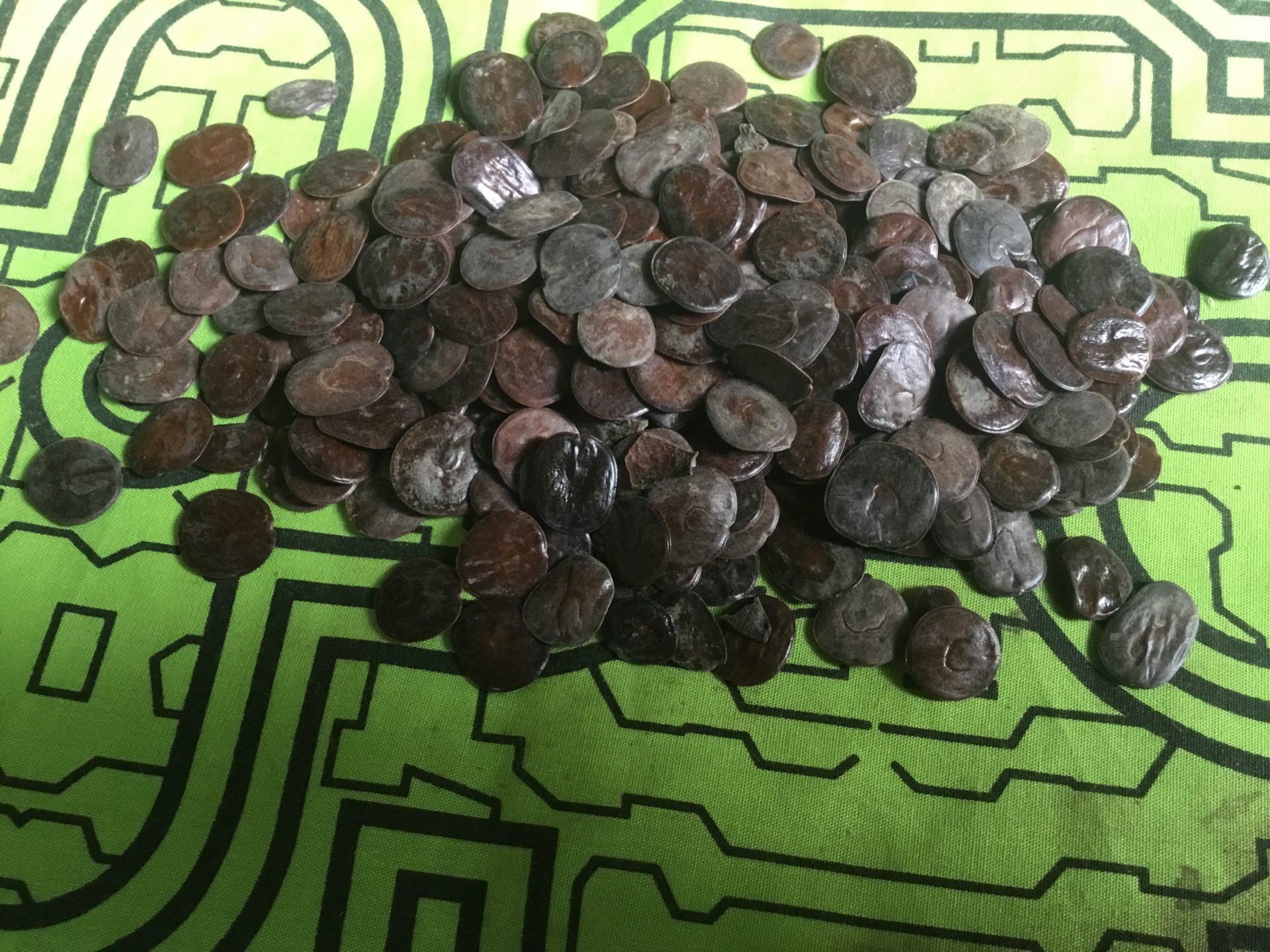
Yopo
Yopo (anadenanthera peregrina) is a large legume tree native to the Caribbean and South America. It grows up to twenty metres tall and produces copious numbers of seed pods. Importantly, each pod possesses between three and ten flat beans or seeds. When prepared and dried, these seeds become a potent psychedelic. Unfortunately, the shamanic use and history of yopo, jopo, cohoba, parica, or calcium tree has disappeared into the mists of time, Europeans first describing its use in 1571 and oppressing its usage in the subsequent century.
The primary active ingredients in yopo hail from the DMT family – 5-MeO-DMT, 2,9-dimethyltryptoline, and DMT-oxide to name a few – but they are not the only alkaloids present in the seeds. There are a number of other active ingredients in the fruit and bark of the yopo tree, such as bufotenin, catechol, methyltryptamine, and saponarentin.
Yopo is of particular interest because it contains monoamine oxidase inhibitors (MAOIs) and bufotenin in addition to the forms of DMT. However, it is unclear if the bufotenin is active or chemically “locked” and, therefore, unavailable.
For thousands of years, South American shaman have used yopo as a psychedelic snuff. Indigenous cultures have allowed it to help shape their spiritual landscape. The earliest evidence of yopo use was discovered in Inca Cueva, Argentina where puma bone pipes accompanied by anadenanthera peregrina seeds were radiocarbon dated to 2130 BC, indicating people have used yopo for over 4000 years. Similarly, snuff trays and pipes dating back to 1200 BC have been uncovered on the central Peruvian coast.

Bufo
As incredible as it may seem, the use of this small animal has its origins in indigenous ancestry. Thus, there are many iconographic and mythological representations of toads in the Olmec, Mayan and Aztec cultures that date back to 2000 B.C.
The Sonoran Desert hosts the largest amount of this species in Mexico.
People who have consumed this medicine claim that it produces an oniric-like effect. You awaken from a dream after having a kind of revelation. The ‘Toad of Dawn,” as it is also known, expels 5-meO-DMT from its skin.
The neurotransmitter molecule is called Bufotenin. It is collected from the toad’s skin, without causing any damage to it. The liquid is then dried. Once crystallised, the effect on the psyche begins.
Once inhaled, Bufotenin immediately reaches the brain in the form of 5meO-DMT. In fact, it is able to cure addiction to hard drugs, such as methamphetamines. Interestingly, our brain has certain kinds of filters. These are inhibited in our normal state of consciousness. Consequently, we perceive our reality in three dimensions. Breaking these filters with the “medicine,” makes our ego disappear. We go into very deep introspection. In this state, we are able to connect with the subconscious part of our mind.
Others claim that it creates a kind of mental evolution. A short moment of death and rebirth. One of the most transcendental experiences.
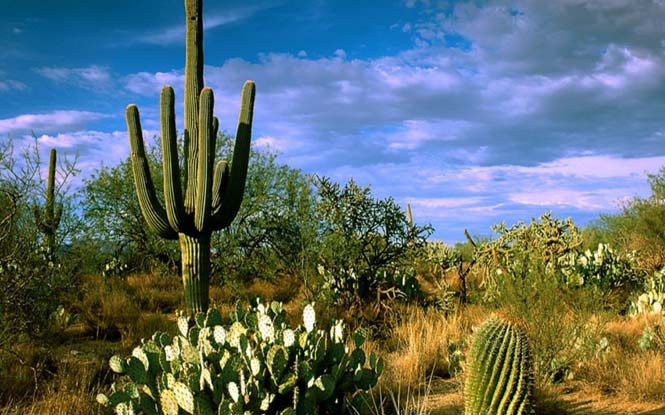
Huachuma (San Pedro)
Huachuma is more commonly known as San Pedro in the Western world, or currently known as Echinopsis pachanoi in the scientific literature. It is also sometimes called ‘wachuma’ by Westerners. Huachuma is a tall (up to 20 ft), light green, night blooming, nearly spineless, columnar cactus native to the Andes Mountains. In its native habitat it grows at altitudes of 6,600 – 9,800 feet. This cactus is found in parts of Columbia, Ecuador, Peru, Bolivia, Chile, and Argentina, but is also cultivated in neighboring countries and many other parts of the world. It is considered the most ancient and revered plant teachers amongst the shamans of northern Peru.
The following alkaloids are generally found within E. pachanoi: Mescaline (25 or more mg per 100 grams of fresh cactus), 3,4-Dimethoxyphenethlamine, 3-Hydroxy-4,5-dimethoxyphenethylamine, 3-Methoxytyramine, 4-Hydroxy-3,5dimethoxyphenethtlamine, Anhalonidine, Hordenine, and Tyramine. The concentration of these alkaloids can vary widely for each plant.
“Huachuma contains mescaline, which is a phenethylamine and is chemically related to MDMA [ecstasy], while LSD, DMT [the main compound in ayahuasca] and psilocybin [the main compound in mushrooms] are in the tryptamine family.” mescaline is unique among the major hallucinogens in that it is a phenethylamine.”
San Pedro has a rich history of sacred shamanic use. It has been used to treat various ailments such as cancer, diabetes, hepatitis, fever, paralysis, problems with joints, high blood pressure, cardiac diseases, burning kidneys, and bladder to name a few. San Pedro is also a powerful antimicrobial that inhibits 18 or more penicillin-resistant bacteria.
These scared cacti like other indigenous entheogens are miracle plants. San Pedro has also been noted to cure drug addiction and alcoholism.
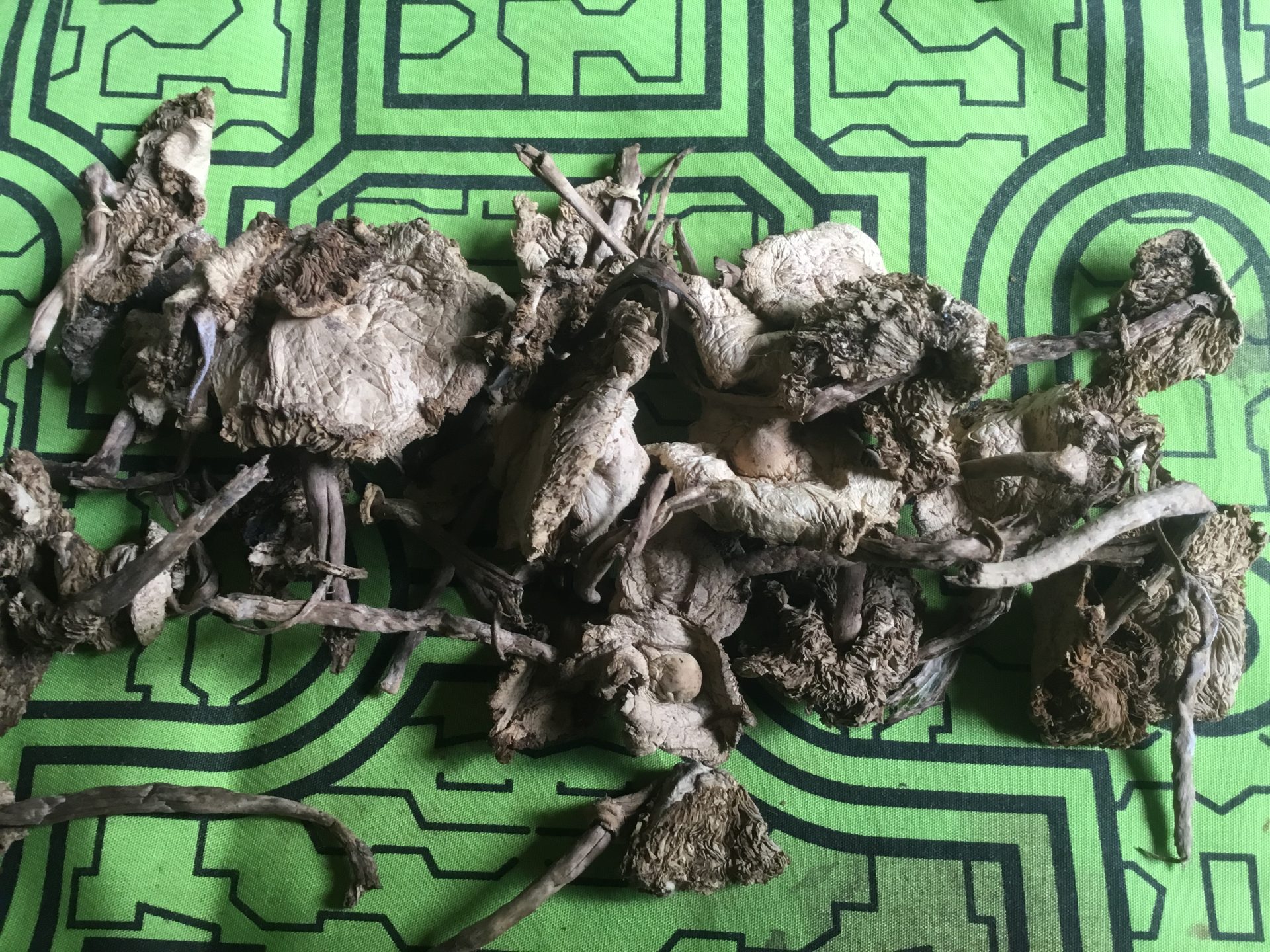
Magic mushrooms (psilocybin)
The indigenous say that mushrooms are born in the place where lightning strikes, and that is the mystical reason why they have great power.
In ancient times magic mushrooms were the portal and the key to the spiritual world. Through rituals they helped heal the sick and allowed communication with their gods. Xochipilli, the Mexica god of flowers and plants, has headdresses that represent entheogenic plants, including Psilocybe mushrooms.
One of the first testimonies about the use of magic mushrooms was made by a Spanish cleric in Mexico. He describes the effects of teonanácatl (Nahuatl for ‘meat of the gods’) thus: “those who eat them begin to get excited and dance, sing, cry. Some don’t want to eat, just sit…and see themselves dying in a vision.”
Those who have consumed them can easily understand why it was a channel of communication with the gods, as well as a way of understanding the magic of the universe.
Some time after these reports, the use of sacred mushrooms was prohibited as part of religious indoctrination and imposed catechism. For this reason its consumption was kept secret and syncretism gave rise to new traditions.
When one ingests Psilocybin (the active component of magic mushroom), the gut converts it to its active metabolite, psilocin, which binds to serotonin 2A receptors. Researchers believe that this is what triggers “neuronal avalanching,” or essentially a domino effect of different changes in the brain’s many domains, from heightening activity in the visual cortex to decreasing activity in the default mode network, leading to what many describe as a ”loss of ego.” Further, Psilocybin increases connectivity among different regions of the brain, which ordinarily operate fairly independently, or in a compartmentalised fashion.
In a study from Yale University, researchers demonstrated that a single dose of Psilocybin in a laboratory mouse model prompted a long-lasting increase in connections between neurons. This has implications, many researchers argue, for depressive patients, because chronic stress and depression are known to drastically reduce neuronal connections in the brain.
Further, a 2021 study found that a dose of Psilocybin increases dendritic spine density within 24 hours of ingestion. An increase in spine density correlates to an increase in the number of excitatory synapses per neuron, which means more neuronal connections. More neuronal connections translate to better memory, increased capacity for learning, and less proclivity for depression and anxiety.
According to ClinicalTrials.gov, there are a number of compelling studies to be on the lookout for all over the globe. For example, the Psychiatric Center Copenhagen at Rigshospitalet in Copenhagen is currently in the preliminary stages of designing a study evaluating Psilocybin’s efficacy as a treatment in patients with alcohol use disorders. Another promising study is currently recruiting at the University of California San Francisco and is exploring Psilocybin’s therapeutic potential in treating individuals suffering with depression and anxiety alongside Parkinson’s Disease. Also at the University of California San Francisco, a preliminary study is evaluating Psilocybin therapy for depression in Bipolar II. Several other studies – many of which are presently underway – are focused on Psilocybin’s effects on Major Depressive Disorder, including the Pacific Neuroscience Institute in Santa Monica, California, Yale University, Kadima Neuropsychiatry Institute in La Jolla, California, and Sheaf House Talaght Hospital in Dublin, Ireland. It appears that there will be particular attention devoted to the exploration of Psilocybin as an antidepressant medication, given its new status as a “breakthrough” drug with the FDA in recent years. Other studies of interest address Psilocybin’s potential role in the treatment of Body Dysmorphic Disorder, Anorexia Nervosa, and Obsessive Compulsive Disorder (OCD).
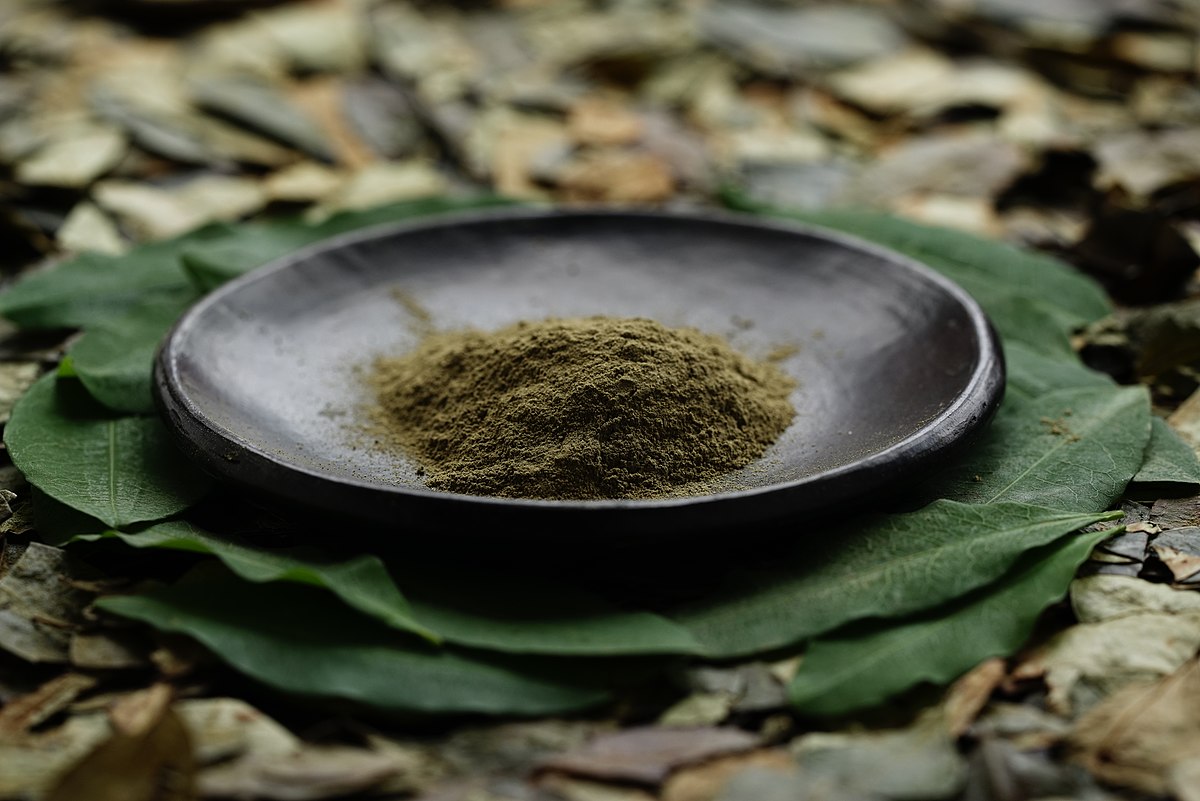
Mambe’
The Mambe is an excellent remedy with rich in benefits.
At a nutritional level, it is a supplement containing proteins and vitamins (Potassium, Calcium, Phosphorus, Iron, Sodium, Vitamin A, E, B1, B2, B3, and C).
The main effect is to give you energy; for this reason, it’s common to assume Mambe to endure long work days, mainly when cultivating and harvesting, since it contains alkaloids that stimulate concentration and physical and mental endurance. Also, we could see a growth of students that assume Mambe, researchers, and professors that rely on it to concentrate over long hours. Another effect of this powder is to reduce pain; we recommend using it in case of physical pain due to its natural anti-inflammatory and anesthetic properties.
More Benefits:
– It grants ease of communication.
– Increases concentration.
– Sensory activity improves.
– Reduces fatigue and hunger; hence it is used in long-term physical activities.
– Slimming.
– Analgesic, Antirheumatic, Energizing.
– Cure gastritis, osteoporosis, chronic tonsillitis, sinusitis, and hemorrhoids.
– Reduce stress and insomnia.
– Reduce inflammation of the colon, triglycerides, and cholesterol, among others.
– Great nutritional qualities, contains almost three times more fiber than legumes, fruits, and vegetables.
– It contains proteins and vitamins at high levels.
Traditionally, the indigenous people of the Amazon use the Mambe together with the Ambil (a tobacco-based paste). They take it at various moments of the day. Still, the presence of this medicine is essential during Community meetings when leaders and elders get together to decide how to organise the community, how to heal a specific disease, and how to take care of the territory and nature. “Mambear” from Spanish means the act of assuming Mambe.
The ceremony of Mambe usually occurs in a specific sacred area around the fire. Firstly Mambe is being shared with all the people that are sitting in the meeting. Then, the elder starts talking about an important topic opening the space for the so-called “Circulo de Palabras” (Words Circle). After that, the seated people listen attentively, and each person can express their own opinion about the topic. This exchange of thoughts can last hours, and the remedy of Mambe is assumed to maintain the attention alive, connect with the heart, and let the feeling express the words.
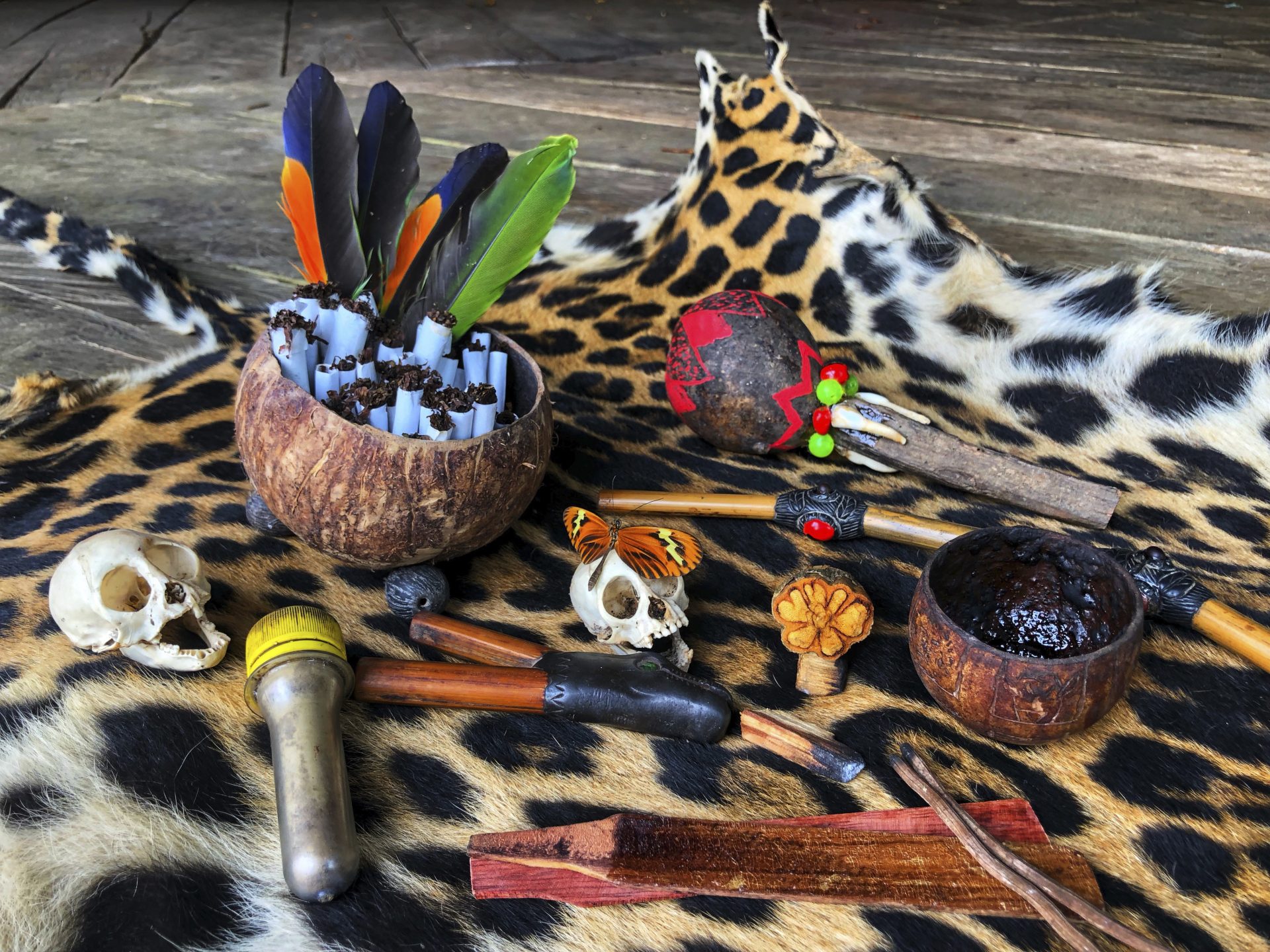
Rape’
Its name comes from French and means “grated” (grated tobacco); Its origin is ancient and it is prepared by shamans.
Rapé is a mixture of various Amazonian plants these are roasted and ground whose base is tobacco; Acre in Brazil is the place that has the greatest tradition in rapés and many varieties
When rapé is applied, it must be done with respect from those who blow it and from those who receive it and with the awareness that an ancestral medicine that possesses the powerful spirit of the mountain, the forest, the jungle.
Its effects and benefits are at various levels both in the physical body, in mental and psychic states as well as in the spiritual aspect.
• It is very effective in treating respiratory system problems such as sinusitis, rhinitis as it helps expel dirt, mucus and parasites from the frontal and nasal sinuses.
• Healing and antibiotic applied on wounds.
• Used in nicotine detoxification
• It expels the excess of accumulated phlegm caused by food and the particles of all the atmospheric contamination that are stored.
• It is also very powerful to treat the digestive system, deworms, cleanses and helps intestinal peristaltic regulation.
• Decompresses the pressure of the skull
• Eliminates headaches, body aches, dullness and lightheadedness
• On a psychological level, it treats fears and anxiety.
• Calms the mind and stops the internal dialogue, quieting the thoughts and opening the inner silence, providing relaxation and serenity because the snuff frees the brain from burdens and blockages.
• Cleanses, orders and aligns your energy fields, especially the third eye and crown chakras, and from there up and down the spine.
• The body loosens up and loosens up when receiving the snuff, remaining in an excellent state for meditation.
• Removes anxieties and other emotions and energies connected to the solar plexus, causing the person to vomit the dense energies accumulated there.
• It is possible that with a strong breath the person reaches deep states of connection with their areas of unconsciousness
• Commonly used during Ayahuasca shots to intensify or unclog processes.
• Useful to treat depression, obsessive fears, insomnia and anxiety among others.

Sananga
The plant-based sananga eye drops—brewed from the Tabernaemontana genus of shrubs native to the upper Amazon—are said to enhance eyesight and have long been used by indigenous tribes to prevent and treat ocular diseases like glaucoma, cataracts, near-sightedness, and blindness. But sananga is also commonly used to treat skin diseases, infections, arthritis, cancer, and perhaps most interestingly, to clear a person of what is called panema—anxiety, depression, bad luck, negative energies, and laziness.
In fact, it’s by clearing this panema that sananga is said to promote overall eye health. As a shaman would explain it, sananga does its work not at the physical or cellular level but rather on an energetic level.
The specific ingredients of sananga change depending on the particular tribe preparing it, and people say the effects also differ slightly. The sananga eye drops used most popularly today is prepared in the tradition of the Matsés tribe with the species Tabernaemontana undulata (called becchete in the local language).
While the two species used most commonly for sananga haven’t been researched as thoroughly, the Tabernaemontana genus as a whole has been studied since the 1970’s. This genus has shown some powerful medicinal potential, and while we can’t assume that the sananga species share all the same properties, it does provide interesting fodder in the discussion for how and why exactly sananga works to treat ocular problems.
Studies on the Tabernaemontana genus have shown the following properties:
Antimicrobial: Studies from 1984 and 2002 show that the species T. pachysiphon and T. angulata have antimicrobial properties effective against a variety of bacteria. The bacteria species targeted include Staphylococcus aureus, which can cause skin infections and respiratory infections, and Pseudomonas aeruginosa, a notoriously drug-resistant bacteria linked to pneumonia, sepsis, and eye infections in people who wear contact lenses.
Antifungal: A 2009 study showed that extracts of T. stapfiana was effective against a variety of fungi species, including Candida albicans, a yeast that can cause thrush in the mouth and yeast infections in the vagina. While Candida infections are typically easy to treat, the fungus poses risk to people with compromised immune systems.
Antioxidant: The Tabernaemontana genus also has strong antioxidant properties. While nutritional antioxidants are widely known for their value in maintaining general health, ongoing research also suggests antioxidants could play a critical role in preventing age-related ocular problems like cataracts and macular degeneration.
